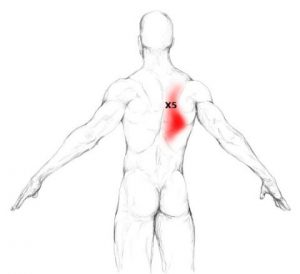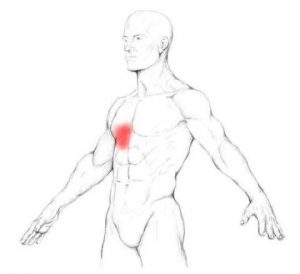Iliocostalis Syndrome
Description
Iliocostalis Lumborum is the most inferior and lateral of the erector spinae muscles.

Action
- Extension of Spine: Acting bilaterally, extension and hyperextension of the spine. Acting unilaterally, laterally flexes the spine
- Respiration: It assists as an accessory muscle of expiration, due to its insertion on the ribs
- Stabilization of Spine: Iliocostalis lumborum along with multifidus contribute to support and control the orientation of lumbar spine.
Clinical Relevance:


- Myofascial pain of Iliocostalis Thoracis- Lumborum muscle causes anterior torso pain. The pain of myofascial origin is a well-recognized pathology characterized by the presence of two components: referred pain; which is often distant from its source and specific to each muscle, and the trigger point, a localized hyperirritable band present in the affected muscle and able to reproduce the referred pain when stimulated. The most common locations of pain were the right-lower quadrant and the left side of the chest. Unsurprisingly, since the referred pain of myofascial pain of the Iliocostalis muscle is located at the frontal aspect of the torso (chest, abdomen, and pelvis), it is a clinical challenge even to seasoned clinicians. The anterior torso pain often results in extensive workups before Iliocostalis Lumborum myofascial pain diagnosis is made.
Treatment
Strengthening exercises:
1. Prone extension exercise:
a) In prone lying, have the patient tuck in the chin and lift the head, thorax of the plinth.
b) To progress further, the patient can vary the arm position. Resistance can be added by using hand-held weights.
c) Patient can further progress by lifting one leg off the mat alternately, and progress to both legs simultaneously.
d) Further progression can be made – spine extension with both upper limbs and lower limbs lifted off the mat.
2. Prone exercises on a stability ball.
3. Plank and quadruped exercises to develop control and strength in spinal extensors.
4.Postural exercises.
How to Self-Release the Iliocostalis Thoracis
You will need a ball and a wall to self-massage the Iliocostalis Thoracis. To locate the trigger point, feel for sensitive spots next to and all along the spine, close to the inner border of the scapula. Place the ball over your TrP and lean back on it. Hold for about 30 seconds and release. Please DO NOT use this method for any other trigger points above the chest (i.e. the neck (the Iliocostalis Cervicis area)). We also recommend finding a qualified professional for anything more intense.



Colgan Osteopath in Kettering Northamptonshire
Colgan Osteopath in Hatfield, Hertfordshire
To book an appointment, call 07738493974 or book online
